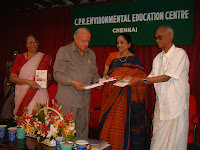Madras Week: Madras and the Paleolithic connection


In 1999, the C.P. Ramaswami Aiyar Foundation published ‘Madras to Chennai’ for a project on ‘Clean Chennai – Green Chennai’, supported by the environmental orientation to school education scheme of the ministry of human resource development. About 350 schools were covered and the book was distributed free to them.
According to Nanditha Krishna, director of the Foundation, in 2008, when Dr K.V. Raman’s (retd. professor and head of the department of ancient history and archaeology, University of Madras) book ‘The early history of the Madras region’ was re-published (during Madras Week), she realised that the city’s history went back to ancient times – the Paleolithic era – and that it played a major role during the Pallava period. She says that the first Paleolithic relic in India was found in Pallavaram, and Nandivarman III, the Pallava king, was even known as ‘Mylai Kaavalam’ or ‘Protector of Mylapore’.
“We realised that the children were unaware of their history and the environment and there was no simple material that could be used to teach them. That was when I felt that it was imperative to write a simple book which would be readable by the young and the old, and that is how the book (‘Madras-Chennai, its history and environment’) came into being,” Nanditha says. The royalties earned from the sale of the book will go to fund the Foundation’s education charities. The Foundation runs two schools in Chennai, but Nanditha is looking at getting the book introduced in many other schools as well.
‘Madras-Chennai, its history and environment’, written by Nanditha herself, was formally released on August 19 by Dr M.S. Swaminathan, chairman of the C.P.R. Environmental Education Centre (CPREEC). Dr Raman, who was present, talked about Roman writers referring to Madras, about Thiruvalluvar residing in the city, inscriptions of Dantivarman in the Triplicane temple, several temple inscriptions classified as belonging to the Pallava and Chola period being found in temples in Velachery and Adambakkam, and the existence of committees to control agricultural operations 1,000 years ago.
Pictures show the book being released; (l-r) Bargavi Devendra, honorary secretary, CPREEC, Dr Swaminathan, Nanditha, and Dr Raman.
Comments